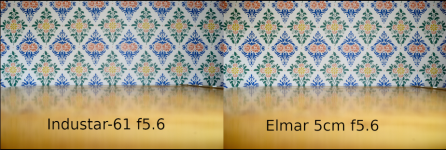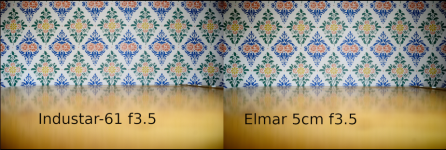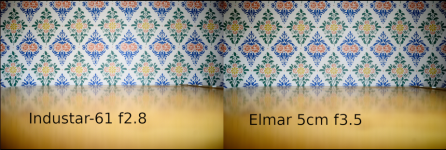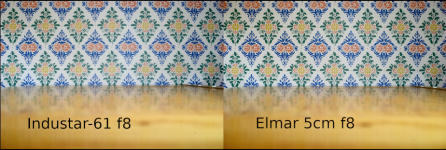Remember that Focus Shift due to Aperture means the focal length is changing slightly- and the change is not the same. SO- lenses used wide-open might have the same focal length, but stopped down to F8- have a different focal length. On top of that, the +/- 1% deviation means two samples of the same lens could be as short as 51.9mm and as long as 52.9mm.
The Zorki and Fed are calibrated for the nominal 52.4mm- the lenses must conform to that at some aperture, or will need to be adjusted (shimmed).
The Zorki and Fed are calibrated for the nominal 52.4mm- the lenses must conform to that at some aperture, or will need to be adjusted (shimmed).
essbe
Newbie
Interesting, I did not know that, about aperture and focal length. When testing them out, I find it quite hard to see though. Here at 2m, the industar-61 on the left side looks the same as, or slightly wider, than the elmar at every aperture (too bad the view shifted a little bit to either side sometimes when I changed aperture, makes comparison a little bit more difficult).
Attachments
AndersG
Well-known
In my small experience (but from 2005 to now) the difference in focus with a Canon 7 and some Soviet lenses is not noticeable for my 50mm (Jupiter 8 and Industar 61) and 35mm (Jupiter 12) lenses. With my Jupiter 11 135mm f/4 on the other hand it is noticeable at closer distances.
I don't often use the largest aperture of the lens, though.
I don't often use the largest aperture of the lens, though.
Coldkennels
Barnack-toting Brit.
As I learned to my horror recently, the Visoflex - at least the first one - is similarly afflicted. I mounted it to a Zorki 5 and couldn't remove it as the wedge cam follower got locked inside the Visoflex. Luckily I could lift the mirror out of the way and physically push the follower into the camera; if something similar had happened with a lens, it'd be a pretty difficult thing to fix on a bottom-loader like the Z5.You must also remember that the shape of the FSU Cam follower is a wedge, not a wheel. There are many lenses that work on a Leica that will jam on an FSU camera.
I think I've mentioned this on here before, but I've started to wonder if this is the reason the FSU "LTM" cameras (we really need a better name for these - STM (Soviet Thread Mount), maybe?) had the wedge shaped cam follower? It is a very trivial job to rotate the cam follower on a FED or Zorki to match the close-focus position of a true LTM lens; of course, you need to then readjust the infinity focus, re-check the close focus and adjust the follower cam as needed, and repeat until both ends agree. Long-winded, but very simple.The lenses made for the Leica will front focus on the FSU cameras, and the shim needs to be reduced. I adjusted the camera instead.
Converting a Leica or Canon to "STM" would not only be marginally foolish, but a lot more difficult.
Coldkennels
Barnack-toting Brit.
@essbe, I've spent a lot of time thinking about this over the years - admittedly not as much or to anything like the technical depth of Brian - but here's what I found/figured out.
First, most of the (early) talk about FSU lenses on the internet complained of sample variation, and blamed the problem on shoddy workmanship. That's never sat well with me. After all, most of these lenses have been tinkered with or even outright butchered over the years. There is definitely some optical variation, as explained by Brian above, but it's still impossible to make claims like "Soviet lenses work fine on my Leica" without explanation or investigation because you don't have any clue what might have been done to the lenses you own or use throughout their lifespan.
So, looking at the historical and technical information available, it seems pretty clear that what's happened is that the Soviets used the same designs, tooling, and specs as they were using for the Kievs - in other words, the Zeiss material they took after the war - and applied that to make lenses for the "Soviet Thread Mount" camera families that had got their start with non-standardised lenses before the war.
If I'm understanding everything correctly, what that means is that the resulting cameras (and lenses) use the Contax standard for translating lens movement to the rangefinder, and that's where that 52.4mm figure comes from. It's not necessarily the real focal length of the "50mm" lenses, but that's what the rangefinder is expecting, so whether you're using a 35mm, "50mm", or 85mm lens, the rangefinder has to translate the travel of the lens' focusing helical and rangefinder cam to that 52.4mm standard - and as the Leica and all other LTM cameras use a 51.6mm standard, the discrepancy between the two always results in focusing errors unless the lens is adjusted in a way that negates it.
In real terms, that translates to Soviet lenses (of all designs and focal lengths) back-focusing a consistent amount on Leica, and Leica lenses front-focusing on a Soviet camera - unless those adjustments have been made to the lens at some point, of course.
The first method I used to try to show this was by doing a tightly controlled test with a Leica fixed on a tripod at 1m from a range of Soviet bodies, as shown below. As I only had a Canoscan at the time (which doesn't produce scans to any level of detail or sharpness), I then wet-printed from the resulting negatives to ensure I got the best possible representation of the images. Here's the image I put together from those prints:

Soviet Lens Tests, Redux. by Tony Gale, on Flickr
The lenses used were a collapsible Summicron, a black Jupiter 8 from 1976, a 1960's Industar 26m, and an unusual collapsible Industar 22 from the KOMZ factory (most were made in KMZ) - I tried to pick a spread of lenses that not only represented different production eras and lens designs, but also ones that I could guarantee hadn't been tampered with and that had all been purchased from different places. On top of that, I'd used all of them to produce great and perfectly focused photos on FED and Zorki bodies over the years. I forget what aperture I used, but considering the inclusion of the Industar 22 (an f/3.5 lens) and the similar depths of field, I think these were probably all at f/4 to standardise everything.
It should be pretty clear that all of the Soviet lenses not only backfocus, but backfocus consistently - in other words, all by the same amount. And considering the way I picked these lenses out of the collection, there's no way this is down to sample variation or chance. I'm 99.9% certain that all unmolested Soviet lenses will behave this way.
Since then, I've worked out a faster and more easily demonstrable test - something you can do at home. If you set up a close-focus test using a vertical object with a flat plane and strong contrast - I have an old cultural theory book that's perfect for this - and measure 1m from the object (i.e. the front cover of said book) to a Leica's film plane, you should be able to focus a Leica lens and get the RF and focusing ring to match, confirming a perfect 1m; you might have to move the tripod laterally slightly to get everything to line up right. Once it does, you're set, and you've got your control. Now change the lens for a Soviet one (without moving the Leica, obviously), and try focusing with the RF; when the images in the RF align, look at the focusing ring, and it'll be at roughly 1.1m, suggesting a back focus of approximately 10cm. Replace the Leica with a FED or Zorki and a Leica lens, and you won't even be able to get the RF to line up with most LTM lenses; my Elmar 50/3.5 hits the close-focus stop on a FED 5 before the images align, and a 28mm Voigtlander Color-Skopar lands at 0.9m when focusing with the rangefinder at a 1m distance, indicating a front focus which nicely mirrors the 10cm measurement on the STM-on-Leica test.
To me, this definitively proves there's a systemic incompatibility here, regardless of how much some people continue to suggest otherwise.
Now, the final question is "does this matter?" For me, yes. I'm very hyper-aware of missed focus in photos - it drives me insane - and the fact that the Soviet 50mm lenses are still exhibiting severe back focus at f/4 at their closest focus on a Leica makes them basically unusable for me. I've even spotted it in my photos with a Jupiter 12 on a Leica, so that stays firmly on a FED now. However, if you never shoot anything close up, or are used to shooting with zone focusing (which should work fine) and never touch the rangefinder, knock yourself out - you probably won't have a problem with Soviet lenses on a Leica.
But personally, I'm treating both "STM" and LTM as the two totally different systems they seem to be, and never mix-and-match between the two.
First, most of the (early) talk about FSU lenses on the internet complained of sample variation, and blamed the problem on shoddy workmanship. That's never sat well with me. After all, most of these lenses have been tinkered with or even outright butchered over the years. There is definitely some optical variation, as explained by Brian above, but it's still impossible to make claims like "Soviet lenses work fine on my Leica" without explanation or investigation because you don't have any clue what might have been done to the lenses you own or use throughout their lifespan.
So, looking at the historical and technical information available, it seems pretty clear that what's happened is that the Soviets used the same designs, tooling, and specs as they were using for the Kievs - in other words, the Zeiss material they took after the war - and applied that to make lenses for the "Soviet Thread Mount" camera families that had got their start with non-standardised lenses before the war.
If I'm understanding everything correctly, what that means is that the resulting cameras (and lenses) use the Contax standard for translating lens movement to the rangefinder, and that's where that 52.4mm figure comes from. It's not necessarily the real focal length of the "50mm" lenses, but that's what the rangefinder is expecting, so whether you're using a 35mm, "50mm", or 85mm lens, the rangefinder has to translate the travel of the lens' focusing helical and rangefinder cam to that 52.4mm standard - and as the Leica and all other LTM cameras use a 51.6mm standard, the discrepancy between the two always results in focusing errors unless the lens is adjusted in a way that negates it.
In real terms, that translates to Soviet lenses (of all designs and focal lengths) back-focusing a consistent amount on Leica, and Leica lenses front-focusing on a Soviet camera - unless those adjustments have been made to the lens at some point, of course.
The first method I used to try to show this was by doing a tightly controlled test with a Leica fixed on a tripod at 1m from a range of Soviet bodies, as shown below. As I only had a Canoscan at the time (which doesn't produce scans to any level of detail or sharpness), I then wet-printed from the resulting negatives to ensure I got the best possible representation of the images. Here's the image I put together from those prints:

Soviet Lens Tests, Redux. by Tony Gale, on Flickr
The lenses used were a collapsible Summicron, a black Jupiter 8 from 1976, a 1960's Industar 26m, and an unusual collapsible Industar 22 from the KOMZ factory (most were made in KMZ) - I tried to pick a spread of lenses that not only represented different production eras and lens designs, but also ones that I could guarantee hadn't been tampered with and that had all been purchased from different places. On top of that, I'd used all of them to produce great and perfectly focused photos on FED and Zorki bodies over the years. I forget what aperture I used, but considering the inclusion of the Industar 22 (an f/3.5 lens) and the similar depths of field, I think these were probably all at f/4 to standardise everything.
It should be pretty clear that all of the Soviet lenses not only backfocus, but backfocus consistently - in other words, all by the same amount. And considering the way I picked these lenses out of the collection, there's no way this is down to sample variation or chance. I'm 99.9% certain that all unmolested Soviet lenses will behave this way.
Since then, I've worked out a faster and more easily demonstrable test - something you can do at home. If you set up a close-focus test using a vertical object with a flat plane and strong contrast - I have an old cultural theory book that's perfect for this - and measure 1m from the object (i.e. the front cover of said book) to a Leica's film plane, you should be able to focus a Leica lens and get the RF and focusing ring to match, confirming a perfect 1m; you might have to move the tripod laterally slightly to get everything to line up right. Once it does, you're set, and you've got your control. Now change the lens for a Soviet one (without moving the Leica, obviously), and try focusing with the RF; when the images in the RF align, look at the focusing ring, and it'll be at roughly 1.1m, suggesting a back focus of approximately 10cm. Replace the Leica with a FED or Zorki and a Leica lens, and you won't even be able to get the RF to line up with most LTM lenses; my Elmar 50/3.5 hits the close-focus stop on a FED 5 before the images align, and a 28mm Voigtlander Color-Skopar lands at 0.9m when focusing with the rangefinder at a 1m distance, indicating a front focus which nicely mirrors the 10cm measurement on the STM-on-Leica test.
To me, this definitively proves there's a systemic incompatibility here, regardless of how much some people continue to suggest otherwise.
Now, the final question is "does this matter?" For me, yes. I'm very hyper-aware of missed focus in photos - it drives me insane - and the fact that the Soviet 50mm lenses are still exhibiting severe back focus at f/4 at their closest focus on a Leica makes them basically unusable for me. I've even spotted it in my photos with a Jupiter 12 on a Leica, so that stays firmly on a FED now. However, if you never shoot anything close up, or are used to shooting with zone focusing (which should work fine) and never touch the rangefinder, knock yourself out - you probably won't have a problem with Soviet lenses on a Leica.
But personally, I'm treating both "STM" and LTM as the two totally different systems they seem to be, and never mix-and-match between the two.
Last edited:
essbe
Newbie
Haha, yes, misfocus drives me crazy as well, that is basically the reason for this thread. I have alot of images where focus is on the ears of people, but now I think that is mostly caused by using the jupiter-8 at f8, not the best idea really.
I do not really believe in this quality control argument either. I have tested alot of lenses and I think they preform pretty similarly, especially considering age. Variations in contrast mostly, because of tiny scratches and the like probably. Some, have centering issues, but not too many.
I have done my own testing, using a Nikon z6 to see where the optimal focus for some lenses, and then putting a zorki-5, a Leica M2, and a Leica iif on the same spot with the same lenses, and they all indicate (in principle) the same distance both for my Leitz elmar and my industars (the distance scale on the collapsible industar-22 and industar -50 do not seem to be correct though, indicating a bit over 2 meters when focused optimally, but still correct when putting it on the rangefinder (but this means that if I calibrated close focus on any of my zorkis or feds by reading the distance scale on the collapsible industar-22, focus would not be correct, and if I did a test where I dialed in 1m on the industar-50 and 1m on a leitz elmar the rangefinder would show a difference, because the industar-50 would actually not focus on 1 meter, atleast not my copies), the jupiter-8 seems to be maybe a bit off at wide open on both Leicas and my Zorki-5 (but when stopping down, way off because of focus shift). Also, as shown above, it seems to me that the industars show a similar field of view as the elmar, but the jupiter being a bit tighter. With digital it becomes easier, and cheaper, to test these things. Best thing would be a digital Leica with live view, I guess.
Anyhow, I think it is probably best to test each lens with each camera before putting it to use on film. As I do not use longer lenses than 50mm on my rangefinders, and like to shoot stopped down, focus shift is what concerns me most at the moment, using the elmar on my zorkis or industars on my leicas does not, from my testing, seem to be much of an issue.
I do not really believe in this quality control argument either. I have tested alot of lenses and I think they preform pretty similarly, especially considering age. Variations in contrast mostly, because of tiny scratches and the like probably. Some, have centering issues, but not too many.
I have done my own testing, using a Nikon z6 to see where the optimal focus for some lenses, and then putting a zorki-5, a Leica M2, and a Leica iif on the same spot with the same lenses, and they all indicate (in principle) the same distance both for my Leitz elmar and my industars (the distance scale on the collapsible industar-22 and industar -50 do not seem to be correct though, indicating a bit over 2 meters when focused optimally, but still correct when putting it on the rangefinder (but this means that if I calibrated close focus on any of my zorkis or feds by reading the distance scale on the collapsible industar-22, focus would not be correct, and if I did a test where I dialed in 1m on the industar-50 and 1m on a leitz elmar the rangefinder would show a difference, because the industar-50 would actually not focus on 1 meter, atleast not my copies), the jupiter-8 seems to be maybe a bit off at wide open on both Leicas and my Zorki-5 (but when stopping down, way off because of focus shift). Also, as shown above, it seems to me that the industars show a similar field of view as the elmar, but the jupiter being a bit tighter. With digital it becomes easier, and cheaper, to test these things. Best thing would be a digital Leica with live view, I guess.
Anyhow, I think it is probably best to test each lens with each camera before putting it to use on film. As I do not use longer lenses than 50mm on my rangefinders, and like to shoot stopped down, focus shift is what concerns me most at the moment, using the elmar on my zorkis or industars on my leicas does not, from my testing, seem to be much of an issue.
The Valdai lenses had horrible quality control. This is the nice looking Black Jupiter-3 that often sells for a premium. Avoid them unless photos taken with the lens are provided. I went through 10 of them to get a good one. Most I parted out to use the front elements to replace those in ZOMZ and KMZ Jupiters with really bad front elements. I used the focus mounts for Sonnar conversions. I've seen many machining errors in the Valdai mounts. These were built in the mid 1980s.
essbe
Newbie
Good to know! Actually, I always try to get lenses made at kmz, if possible. Just had the most consistent and best experience from them. But Lytkarino, for example, should be equal I guess?
I've not taken enough LZOS lenses apart to get an answer for that. They were under KMZ, and still manufacture glass.
I've mostly focused on the J-8 and J-3. I have a couple of J-12's, KMZ and LZOS. The KMZ are better, but one has Zeiss optics and serial numbers and the other is Schott glass.
I've mostly focused on the J-8 and J-3. I have a couple of J-12's, KMZ and LZOS. The KMZ are better, but one has Zeiss optics and serial numbers and the other is Schott glass.
phong nguyen
Newbie
Hi,
I did not have many FSU lenses but some such as: Industar 22 - 1 collapsible 50/3.5 ltm (L39), Jupiter 8 50/2, Industar 26-M 5cm/2.8 and used these lenses on my Leica III a and my Leica M6 with L39-M adapter. The results are as follows:
- Industar 22-1 collapsible lens is very difficult to attach to the Leica bodies and can not focus to infinity so I decided not use it on my Leica. I however tried it via L39-M and M-Nex adapter to Sony @A7 II and the pictures are ok.
- For the non collapsible lenses above, they work fine with both Leica IIIa and Leica M6 bodies.
I enclosed herewith some pictures for these lenses.
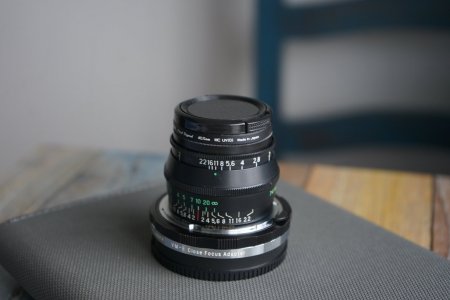
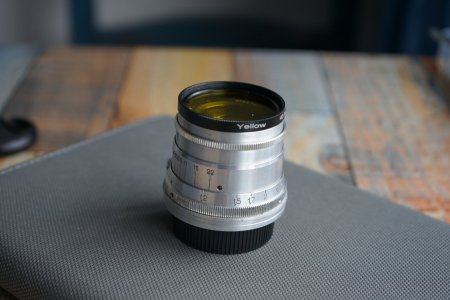
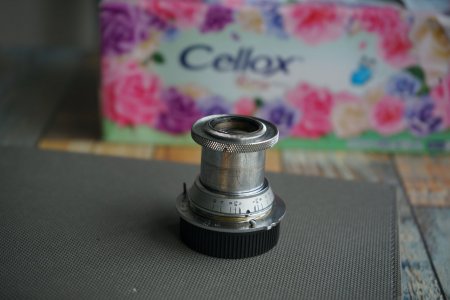
The Jupiter 8, the Industar 26M and the Industar collapsible 22-1.

These pictures are taken by lens Industar collapsible 22-1 on Sony A7 II.
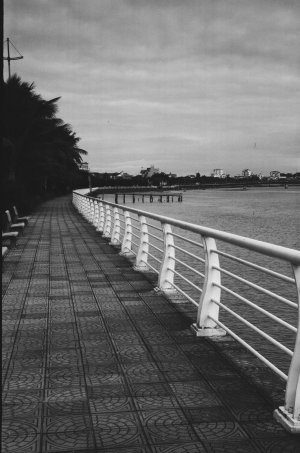
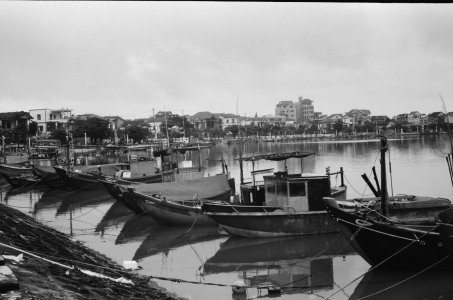
The pictures are taken by lens Jupiter 8 on Leica IIIa on film BW Fomapan 100.
I'd like to listen to other people's ideas concerning this meter.
Thank you for reading.
I did not have many FSU lenses but some such as: Industar 22 - 1 collapsible 50/3.5 ltm (L39), Jupiter 8 50/2, Industar 26-M 5cm/2.8 and used these lenses on my Leica III a and my Leica M6 with L39-M adapter. The results are as follows:
- Industar 22-1 collapsible lens is very difficult to attach to the Leica bodies and can not focus to infinity so I decided not use it on my Leica. I however tried it via L39-M and M-Nex adapter to Sony @A7 II and the pictures are ok.
- For the non collapsible lenses above, they work fine with both Leica IIIa and Leica M6 bodies.
I enclosed herewith some pictures for these lenses.



The Jupiter 8, the Industar 26M and the Industar collapsible 22-1.


These pictures are taken by lens Industar collapsible 22-1 on Sony A7 II.


The pictures are taken by lens Jupiter 8 on Leica IIIa on film BW Fomapan 100.
I'd like to listen to other people's ideas concerning this meter.
Thank you for reading.
Hi,
I did not have many FSU lenses but some such as: Industar 22 - 1 collapsible 50/3.5 ltm (L39), Jupiter 8 50/2, Industar 26-M 5cm/2.8 and used these lenses on my Leica III a and my Leica M6 with L39-M adapter. The results are as follows:
- Industar 22-1 collapsible lens is very difficult to attach to the Leica bodies and can not focus to infinity so I decided not use it on my Leica. I however tried it via L39-M and M-Nex adapter to Sony @A7 II and the pictures are ok.
- For the non collapsible lenses above, they work fine with both Leica IIIa and Leica M6 bodies.
I enclosed herewith some pictures for these lenses.
View attachment 4829779View attachment 4829780View attachment 4829782
The Jupiter 8, the Industar 26M and the Industar collapsible 22-1.View attachment 4829783View attachment 4829784
These pictures are taken by lens Industar collapsible 22-1 on Sony A7 II.
View attachment 4829786
View attachment 4829787
The pictures are taken by lens Jupiter 8 on Leica IIIa on film BW Fomapan 100.
I'd like to listen to other people's ideas concerning this meter.
Thank you for reading.
I've used all of these lenses with my Leica: but all required calibration, meaning changing the shims to focus properly.
The Industar-26m is far better than the reputation it has received: probably due to people using it on a Leica without shimming it first. The lens will usually focus behind what the rangefinder indicates. It is not as obvious as the error for the Jupiter-8 and Jupiter-3, but it is there and makes the image look soft.
I've also shimmed the collapsible Industar-22 and Industar-50 for the Leica. The focus tab is slightly longer than the Elmar lens- and it can hit the slow-speed dial of some cameras. The trick I found: set the lens to close focus and then screw into the camera. This is not a problem when using on an M-Mount camera.
Industar-50 Lube and Adjust
This Industar-50 is a Tessar formula 50/3.5 in a brass mount with "very shiny Chrome". Performance compares well with the post-war 50/3.5 coated Elmar. The I-50 is the third formulation of the 50/3.5 Tessar in the Industar series, it improves on the optics of the Industar-22 and Industar-10. The...
 rangefinderforum.com
rangefinderforum.com
The Industar-50 improves on the Industar-22, uses a newer glass and has higher contrast. Construction is the same, and calibrating the lens is the same as above.
phong nguyen
Newbie
Dear Sonnar Brian,I've used all of these lenses with my Leica: but all required calibration, meaning changing the shims to focus properly.
The Industar-26m is far better than the reputation it has received: probably due to people using it on a Leica without shimming it first. The lens will usually focus behind what the rangefinder indicates. It is not as obvious as the error for the Jupiter-8 and Jupiter-3, but it is there and makes the image look soft.
I've also shimmed the collapsible Industar-22 and Industar-50 for the Leica. The focus tab is slightly longer than the Elmar lens- and it can hit the slow-speed dial of some cameras. The trick I found: set the lens to close focus and then screw into the camera. This is not a problem when using on an M-Mount camera.
Industar-50 Lube and Adjust
This Industar-50 is a Tessar formula 50/3.5 in a brass mount with "very shiny Chrome". Performance compares well with the post-war 50/3.5 coated Elmar. The I-50 is the third formulation of the 50/3.5 Tessar in the Industar series, it improves on the optics of the Industar-22 and Industar-10. The...rangefinderforum.com
The Industar-50 improves on the Industar-22, uses a newer glass and has higher contrast. Construction is the same, and calibrating the lens is the same as above.
Thank you very much for your information and knowledge concerning the FSU lenses on Leica body. I wish I could follow your guidance to calibrate and shim my lenses to use them on my Leica bodies but I could not because I'm just a retire man who'd love to take film photography as a hobby, not a camera technician. I may take the advise from sone people in this forum that it's better to use FSU lenses on FSU cameras and Leica on Leica.
By the way, the Japan made lenses such Canon or Nikon LTM lenses are all working well on Leica bodies (LTM and M). What do you think and your experience about this matter.
Thank you and with best regards,
Phong Nguyen
You are welcome.
The Japanese made Leica Mount lenses will all work correctly on a Leica body. Years ago, the FSU lenses used to be much cheaper than the Canon and Nikon lenses in Leica mount. You could buy a Jupiter-3 5cm F1.5 lens for $50. The Nikon and Canon lenses sold for $400 and above. Now- prices on Canon and Nikon lenses are much lower, and FSU lenses are much higher.
I understand about not wanting to work on these lenses. Myself: I write computer code for a living. Working on lenses and cameras is a hobby to do something completely different.
The Japanese made Leica Mount lenses will all work correctly on a Leica body. Years ago, the FSU lenses used to be much cheaper than the Canon and Nikon lenses in Leica mount. You could buy a Jupiter-3 5cm F1.5 lens for $50. The Nikon and Canon lenses sold for $400 and above. Now- prices on Canon and Nikon lenses are much lower, and FSU lenses are much higher.
I understand about not wanting to work on these lenses. Myself: I write computer code for a living. Working on lenses and cameras is a hobby to do something completely different.
Share:
-
This site uses cookies to help personalise content, tailor your experience and to keep you logged in if you register.
By continuing to use this site, you are consenting to our use of cookies.


